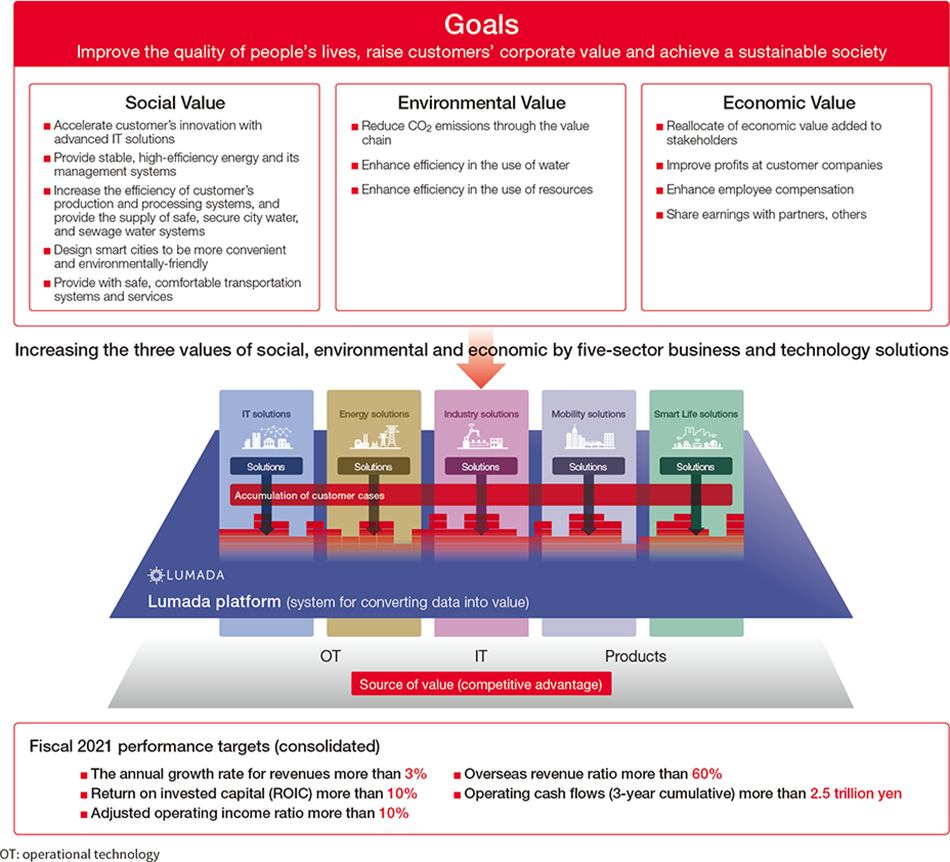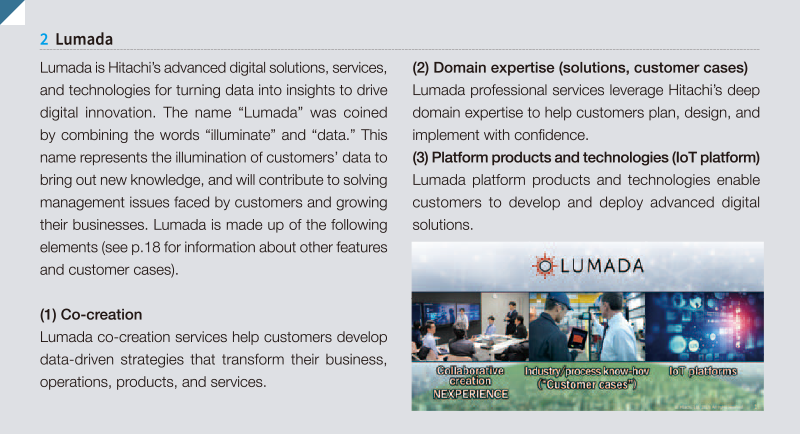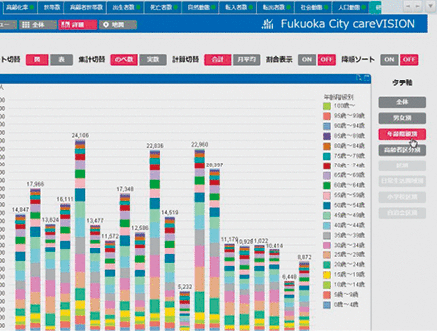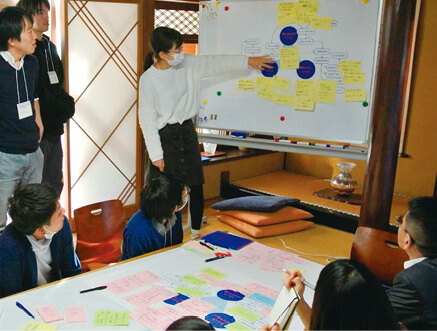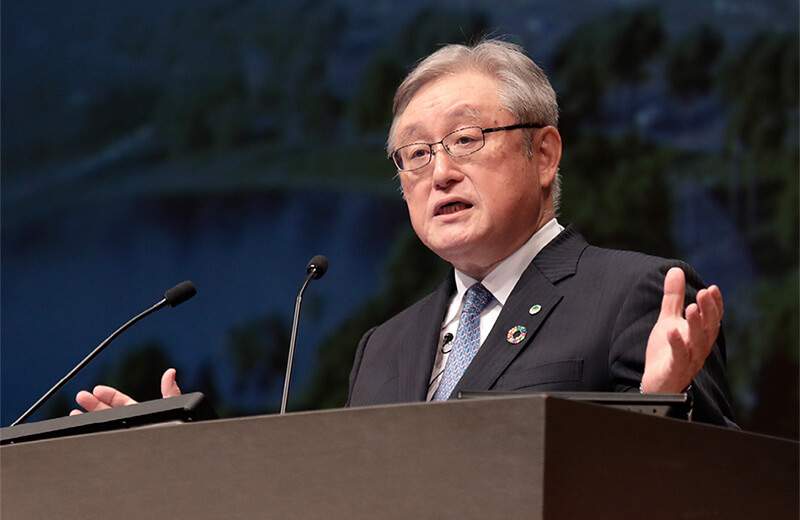Hitachi Social Innovation is POWERING GOODHitachi Social Innovation Forum 2019 TOKYO Keynote Speech
Highlight
The Hitachi Social Innovation Forum 2019 TOKYO was held at the Tokyo International Forum this past October. The keynote speech was delivered by Toshiaki Higashihara, President & CEO of Hitachi, Ltd. Companies are becoming increasingly important players when it comes to using innovation to overcome societal challenges, such as the Sustainable Development Goals and Society 5.0; as such, Hitachi’s new Mid-term Management Plan has set a target of global leadership in its Social Innovation Business, working with customers to increase social, environmental, and economic value. In his speech, Higashihara spoke about both the steps that Hitachi’s Social Innovation Business has taken thus far toward creating a better quality of life and a sustainable society, as well as its plans for the future.

Delighting People with Technological Capabilities and Quality
Hitachi launched its 2021 Mid-term Management Plan (see  ) and created the slogan “Hitachi Social Innovation is POWERING GOOD” to encapsulate its vision for the plan. This phrase expresses our desire to devote ourselves to helping people and reinforces the importance of considering the wellbeing of others in business decisions.
) and created the slogan “Hitachi Social Innovation is POWERING GOOD” to encapsulate its vision for the plan. This phrase expresses our desire to devote ourselves to helping people and reinforces the importance of considering the wellbeing of others in business decisions.
It has been more than 10 years since Hitachi began to pursue “social innovation” and we have learned much during that period as the concept has evolved with changing times and social circumstances.
One example of Hitachi’s social innovation solutions is our Class 395 [1] rolling stock for the UK, which began operations in December 2009. In one incident, approximately 500 people were trapped inside a train that had come to a halt in the Channel Tunnel between the UK and France. To make matters worse, the incident occurred as heavy snowfall in the surrounding areas prevented most trains from operating. Fortunately, the Class 395 train, which can run smoothly even in snowy conditions, came to the rescue and carried the 500 passengers to safety. This incident cemented Hitachi’s reputation for quality products.
The Class 395 is a commuter train serving London and its surrounding areas. It has succeeded in cutting the travel time between London and Ashford in half. One delighted commuter commented, “Not having to leave so early in the morning frees up precious time that I can now spend having breakfast with my children. I am truly grateful for Hitachi’s train.” I take great pride knowing that Hitachi is providing people with more time for the “good things in life.”
Particle beam therapy (PBT) [2] is another important way Hitachi products can help people. Hitachi PBT systems have been used to treat more than 60,000 cancer patients around the world, including one patient who was treated at the MD Anderson Cancer Center in the USA a few years ago. Following his PBT treatment, this patient tearfully told me that “Hitachi’s PBT has helped treat my cancer.” Another patient recovered to such an extent that he was able to successfully complete a marathon three years after undergoing PBT. These accomplishments arose from the tenacity and efforts of engineers who are dedicated to using technology to contribute to society, which brings me great joy.
Collaborative Creation and Digital Technologies that Have Advanced Social Innovation
Nevertheless, when we look at the world today, we see challenges that are increasingly diverse and complex, including urbanization, demographic shifts an aging population, climate change, and the aging of social infrastructure. These challenges cannot be resolved by individual products or companies alone.
It was against the backdrop of these global challenges that the United Nations adopted its 17 Sustainable Development Goals (SDGs) to be achieved by 2030. Meanwhile, in Japan, there is growing buzz around Society 5.0, which aims to create a society in which people can live in safety, security, and comfort. Two keys in achieving these objectives are collaborative creation and digital technologies.
For collaborative creation, Hitachi has established a new facility called Kyōsō-no-Mori (Collaborative Forest) [3] in Kokubunji City, Tokyo. More than merely a place for generating ideas through discussion, Kyōsō-no-Mori provides opportunities for stakeholders to work with researchers and designers to identify challenges and create practical business solutions. We intend to use the facility as a means to accelerate open and collaborative creation with stakeholders from various sectors of society, including business partners, startups, academia, and local government.
In regard to digital technology, Hitachi launched Lumada (see  ) in May 2016. Our aim is to use Lumada to implement future cyber-physical systems (CPSs). CPSs are based on the concept of connecting cyber space with physical space - they use computers (cyber space) to collect data from sources such as sensors located in the field (physical space) that can then be analyzed using technologies such as big data analytics and artificial intelligence (AI), and the results used as feedback to the physical systems. Achieving this requires expertise in both the physical and cyber worlds. Hitachi possesses both operational technology (OT) expertise, acquired from more than a century of experience with the supply, operation, and maintenance of a wide variety of products, as well as IT expertise that it has built up since the 1960s. There are few companies anywhere in the world that combine this three-way mix of OT, IT, and products.
) in May 2016. Our aim is to use Lumada to implement future cyber-physical systems (CPSs). CPSs are based on the concept of connecting cyber space with physical space - they use computers (cyber space) to collect data from sources such as sensors located in the field (physical space) that can then be analyzed using technologies such as big data analytics and artificial intelligence (AI), and the results used as feedback to the physical systems. Achieving this requires expertise in both the physical and cyber worlds. Hitachi possesses both operational technology (OT) expertise, acquired from more than a century of experience with the supply, operation, and maintenance of a wide variety of products, as well as IT expertise that it has built up since the 1960s. There are few companies anywhere in the world that combine this three-way mix of OT, IT, and products.
Collaborative Creation Begins with Sharing Challenges and Understanding
The most important aspect of collaborative creation is the ability to work with customers to identify challenges and achieve a common understanding. It is for this reason that Hitachi uses NEXPERIENCE, a consolidated framework of methodologies for developing new services and business models through joint workshops with customers.
Mitsui Fudosan Co., Ltd. used the experience-oriented approach (one of the NEXPERIENCE methodologies), applying Hitachi expertise in design and digital technology to anticipate what types of offices will be needed in the future. The outcome of this work was the recent re-opening of a common space [4] that had been redeveloped to embody the concept of “making connections.”
A collaborative creation with Amada Holdings Co., Ltd., a major international manufacturer of metal processing machines, was another project that leveraged Hitachi’s manufacturing expertise.
Adapting to changes to production plans, such as the types and quantities of products produced, is a major manufacturing issue at Amada. In the past, common practice was to rely on the accumulated expertise of expert workers to ensure that products were delivered on time. In fact, we face similar concerns in our own operations at Hitachi. In response, we have installed plant sensors to monitor work progress and have developed factory simulators that we can use on Lumada to modify production plans. We invited expert workers from Amada to view our practices; using their know-how, they implemented our practices into their own systems that they could use to coordinate production. I understand that this has shortened the task of production planning by around 80%.
Amada has also introduced a hands-free system for managing work processes [5] that incorporates Hitachi technology for image and voice recognition into three-dimensional (3D) images to provide work instructions. Workplace improvements such as this ensure that even workers who lack experience are able to maintain high levels of skill. I look forward to more examples of collaborative creation such as this that address the skilled labor shortage being felt by the manufacturing industry.
Another collaborative creation - this one with local government - provides an example of how Hitachi’s solutions can cater to the needs of local communities. Rapid aging in Fukuoka City imposes a heavy burden on those who care for the elderly, including families as well as medical and nursing staff. In response, Hitachi has developed an information platform for comprehensive community care [6] that uses digital technology to deal with actual care site needs, connect caretakers and make use of big data analytics. Our platform enables care managers to be dispatched in a timely manner and, ultimately, the elderly to continue living in communities they are familiar with.
Individual Initiative Overcomes Enduring Concerns
One approach that is essential to the future of social innovation is to go beyond current issues to anticipate the challenges that society might face in 30-or 50-years’ time and develop solutions to those challenges now.
Since 2016, Hitachi has established a number of joint research facilities in partnership with universities based on this way of thinking, one of the outcomes of which was a research project entitled “Crisis 5.0: Exploring Societal Issues for 2050” created in collaboration with Kyoto University. Developed through discussion and consultation with the university’s academics in the fields of history, psychology, and philosophy, the project concluded that in 2050, people will be most concerned about having “nothing to believe in, nothing to rely on, and nothing to do.” For example, the further development of virtual reality, which could expand beyond vision and hearing to encompass smell, touch and taste, will likely make it hard to distinguish between the virtual world and the real one. How will we know what to believe? There are also concerns that further advances in the technology of robots and AI will put humans out of jobs.
Hitachi addresses these concerns in “Imagination 5.0” [7]. Our idea is that putting your imagination to work and coming up with solutions to challenges brings vibrancy to people’s lives and helps them overcome these concerns. In other words, these enduring concerns are unlikely to go away no matter how much progress is made in technology. Therefore, it is important for people to be proactive about overcoming challenges, by taking control of technology and establishing their own beliefs to follow, passions to pursue, and challenges to solve.
While this represents just one hypothesis, Hitachi is already adopting this approach to its Social Innovation Business. One example of this is a collaborative creation project involving local residents of Matsuyama City in Ehime Prefecture, in which data on their movements and other aspects of their daily lives is used in town planning. In another example in Kokubunji City, Tokyo, methods are being developed for residents to make use of data in their engagement with the community, including the use of digital technology to help them source local produce.
Human-centric Communities that Maximize the Happiness of Residents
Urban development is one area for which Hitachi is able to draw on comprehensive experience and capabilities acquired from its many years of involvement in the social infrastructure business, including energy, transportation, buildings, and industry.
Despite changing community profiles, needs and service requirements, infrastructure is very difficult to rebuild once it has been put in place. This is why Hitachi seeks to develop infrastructure that can adapt to suit the evolving values of community residents, making the community more attractive the longer you live there. A variety of initiatives are being launched to create communities that are human-centric, maximize happiness, and grow in value over time, known as “Infrastructure-as-a-Service (IaaS) for Happiness.” In other words, infrastructure services that foster happiness.
This concept serves as the basis for a number of developments being undertaken with Frasers Property Public Company Limited, a property development company that is part of the TCC Group, a Thai conglomerate. The “One Bangkok” project in Thailand is one candidate for the supply of such services. One Bangkok is a smart city project on a 16.7-hectare site that includes five office towers, five hotels, three residential towers, shopping, and a wide variety of cultural facilities. With a value that will continue to grow, it will be a human-centric community that will bring happiness to people who spend time there. I look forward to participating in more urban development projects of this nature.
Join with Hitachi in Making the World a Brighter Place
People all have an ego, and a degree of selfishness is common to everyone. On the other hand, feeling at least a little empathy for other people can bring joy. Happiness is something that is not diminished by sharing, but rather that grows when imparted on others. Identifying societal challenges and taking action to resolve them provides a sense of self-worth. Furthermore, if the challenges being confronted are too difficult to be overcome by one person alone, should that not be taken as an opportunity to bring people together?
Everyone in society has the power to make the world a brighter place. I invite you all to join with us at Hitachi in our pursuit of social innovation.

